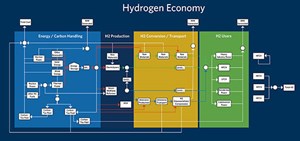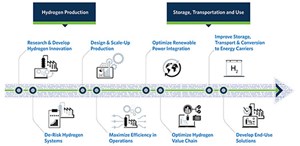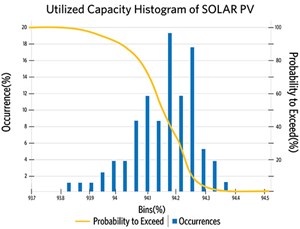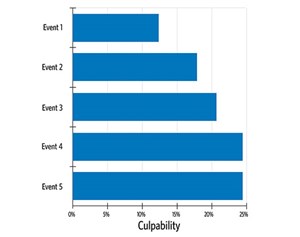Articles
How digital is driving the H2 energy transition
Special Focus: H2 Equipment and Services
G. MUNOZ, Aspen Technology, Bedford, Massachusetts
In recent decades, energy and chemical companies have benefited from digital technologies to increase the efficiency of hydrogen (H2) processes while ensuring safe and economical production, storage and transportation. Today, digitalization is increasingly crucial as H2 systems grow in complexity, utilizing green power sources and getting deployed at a larger scale.
With H2’s new role as a fundamental player in the energy transition and decarbonization of the global economy, many investments are being made to build, repurpose or expand H2 infrastructure around the world. As the demand for H2 increases and new assets bring incremental complexity, variability and uncertainty to the value chain, it is essential to examine reliability and efficiency across all aspects, including electricity supply, H2 production, transportation, storage and utilization. Across the different systems in the value chain, digital solutions will continue to provide value from design, maintenance, operations and supply chain to support and accelerate the transition to a H2 economy (FIG. 1).
Innovation is also required to drive the wide-scale and economical deployment of H2 systems. Digital solutions can accelerate techno-economic analysis and improve the time to market of new technologies, including electrolysis, carbon capture and fuel cells. Models based on engineering fundamentals accelerate the commercialization of low-carbon H2 production and end use, driving innovation to scale and reducing the costs of H2 technologies across the complete value chain.
In the early stages of innovation and development of new projects, process modeling software drives research, design and scale-up and helps to mitigate risk—most H2 electrolysis research during the past dozen years has been conducted with process simulation software. Concurrent engineering solutions improve project execution, reducing the time and resources needed for engineering by 50% or more. In addition, reliability and system-wide performance and risk assessment solutions de-risk and optimize H2 systems early in the design cycle, avoiding unnecessary capital expenditure (CAPEX) and providing guidance to prioritize investments.
Advanced process control (APC) and other production optimization technologies improve safety, energy efficiency and overall operation stability. Additionally, as green H2 technologies are deployed, microgrid management can maintain the reliability of the energy supply to maximize power availability for H2 production.
Across the value chain, digitalization of the transportation network enables comprehensive monitoring and supervisory pipeline control. Process modeling helps to assess the re-use of natural gas pipeline networks for H2, while supply chain management solutions enable the optimization of production and distribution, management of inventories and tracking to ensure operations. Subsurface modeling supports the selection of underground H2 storage locations and carbon sequestration strategies. FIG. 2 outlines the pathway to accelerate innovation, improve economics and ensure the reliability of operations across the H2 value chain.
De-risking end-to-end H2 systems. As H2 technologies scale up, it is crucial to understand the end-to-end, holistic H2 systems needed to optimize pathways, size up processes and make investment choices. Investment choices include equipment, plant capacities and redundancies, the availability of renewable energy sources, battery storage, H2 storage, carrier storage (e.g., ammonia), transport dynamics and alternatives.
Companies are typically involved in only one section of the system (e.g., power generation, H2 production, carbon capture). However, each section is connected upstream and downstream to other parts of this end-to-end system. In addition to this interdependency, complexity and uncertainty increases depending on weather, technology selection, product demand, availability of raw materials and safety requirements. For example, a green H2 facility can utilize its full production capacity only if the electricity supply or storage permits it. In addition, the H2 supply to customers based on demand variability will be limited by the transportation system.
By looking at the entire end-to-end system, it is possible to identify the bottlenecks, understand their magnitude and use probability analysis to predict future performance. System-wide risk modeling looks at the uncertainties and variability across the value chain.
Analysis software looks at different levels, from the equipment to the complete system, to support better decision-making when dealing with uncertainty, risk and reliability. It identifies and quantifies the events that lead to performance losses by evaluating the effect of factors such as equipment reliability and capacities, operations logic, storage limits, maintenance practices, logistics alternatives, weather and market dynamics. Considering these factors, the model predicts the probability of meeting or exceeding key performance indicators such as production, revenue, costs, emissions, energy use or any economic objective (FIG. 3).
To manage uncertainties, it is necessary to look at a forecast into the future. Dynamic, event-driven modeling technology can accurately predict future performance to justify investment and operation decisions that will minimize risks and maximize profits across the asset lifecycle.
H2 systems benefit from risk assessment by obtaining insights into utilization and availability. As the model shows the probability of meeting or exceeding a specific objective, it will also predict the culpability of different events (e.g., what events are to blame for the lost performance), guide the removal of bottlenecks, and realize storage sizing, maintenance strategies, capacities or redundancies to optimize the entire system (FIG. 4).
A system-wide analysis can rapidly evaluate configuration alternatives and explore the impact of energy and product storage, alternative electrolysis technologies and carrier fluids on the overall load factor and lifecycle costs. Understanding the uncertainties will help to size the entire system, especially the batteries and other assets needed to store H2 and energy carriers. This makes it possible to reduce risks, rank investment alternatives quantitatively and avoid unnecessary CAPEX.
As low-carbon H2 systems increase in complexity (e.g., integrating with a carbon capture plant or renewable energy source), it is important to evaluate the effect these complexities will impose on the system. Risk analysis validates integrating new assets and guides investment decisions around storage, transportation, utilities and energy generation, helping to make this system work economically.
With risk and reliability assessment, it is possible to understand the entire system through a holistic interdependent model that promotes better decisions. As all uncertainties and variabilities are considered, the risk is reduced. By understanding the events causing bottlenecks, insights will guide decision-makers to know how and when to best expend monetary resources.
In addition to the economic benefits, accuracy risk and reliability predictions provide insights into future performance, allowing decision-makers to confidently improve the system across the lifecycle, from design to operations, as more local, regional and international H2 demands come online and support the realization of the global H2 economy.
Maximizing operations efficiency. Digital solutions have been used for many years to increase the efficiency of H2 processes. Digitalization helps to improve energy efficiency and overall process stability during the H2 synthesis process and carbon capture in blue H2 production without additional CAPEX.
As H2 companies across the value chain adopt digital transformation initiatives, assets generate large amounts of data. However, insights from data-driven models might be incomplete as physical laws do not constrain the results. Combining data with high-fidelity models can provide additional insights that can help operators perform a truly effective optimization of the asset. These high-fidelity models—based on engineering first principles—can provide digital guidance by evaluating scenarios and predicting performance under unknown conditions.
Data reconciliation inputs plant data into a simulation model to determine a potential solution to the problem the operator is trying to solve. Simulations are crafted to represent a digital copy of the plant infrastructure. When simulations are calibrated to match plant data, they provide a complete picture of plant performance.
A global chemical company has been using process simulation solutions to develop a model that easily reconciles data for a fleet of H2 plants and supports many operational decisions, creating an opportunity for innovative solutions. Knowing more about reactor performance, process conditions and deviations from the simulation helps the organization improve operations efficiency. As reactor activity is reduced, its behavior separates from equilibrium, which cannot be measured directly. A digital model enables engineers to monitor performance proactively and adjust process conditions accordingly to limit the impact of catalyst degradation.
In cases where additional conversion leads to additional capacity, benefits are between $250,000/yr and $500,000/yr. In a different scenario, digitalization also helped them to prevent more than $1 MM in catalyst damage, unscheduled shutdown and catalyst changeout after process control settings had changed to default values during a loss of power trip in a H2 plant.
However, data is not always available, especially as new large-scale electrolysis plants are coming into operation. In this situation, data will be unavailable until the plant is in operation. However, digital solutions can still provide value and help prepare the plant to run efficiently and smoothly. Rigorous process simulation and real-time, dynamic simulation platforms can be integrated to develop high-fidelity digital twins to help operators test and develop the process to prepare a safe startup of the new asset and improve operations performance.
Best-in-class adaptive process control and dynamic optimization technologies will be crucial in the control and reliability of new and complex technologies represented by H2 production and carbon capture. Many refiners use adaptive process control on their existing H2 plants and are leading the implementation of dynamic optimization, which has significantly reduced energy use, H2 loss and flaring at sites like the CEPSA RLR refinery. CEPSA implemented a dynamic optimization solution to balance the H2 network. The optimization reduced more than 70% of H2 losses in the reformer and up to 80% in the remaining H2 network.1
Takeaway. Digital solutions across the H2 value chain are used to prioritize investments, help make technology cheaper to deploy at a wider scale, accelerate project execution and improve efficiency in operations. Risk analysis and production optimization are only some of the areas where digitalization supports improvements and efficiencies across the H2 lifecycle, from design to operations. With these technologies and the latest developments in artificial intelligence, organizations can leverage digitalization to further optimize operations with agility and confidence and help achieve an economically viable end-to-end H2 economy.H2T
About the author

GERARDO MUÑOZ is the Solutions Marketing Manager for Aspen Technology. He joined Aspen Technology in 2010 and is part of the core team leading the go-to-market strategy for sustainability across the portfolio. Muñoz has experience in different process industries, including oil and gas, chemicals, pulp and paper, and cement. He earned a BS degree in chemical engineering from Tec de Monterrey in Mexico and an MS degree in sustainable chemical engineering from Chalmers University of Technology in Sweden.
LITERATURE CITED
1 Aspen Technology, “CEPSA minimizes hydrogen losses and reduces CO2 emissions by optimizing refinery hydrogen network with Aspen GDOT,” 2022, online: https://www.aspentech.com/en/resources/case-studies/cepsa-minimizes-hydrogen-losses-reduces-co2-emissions-by-optimizing-refinery-hydrogen-network





